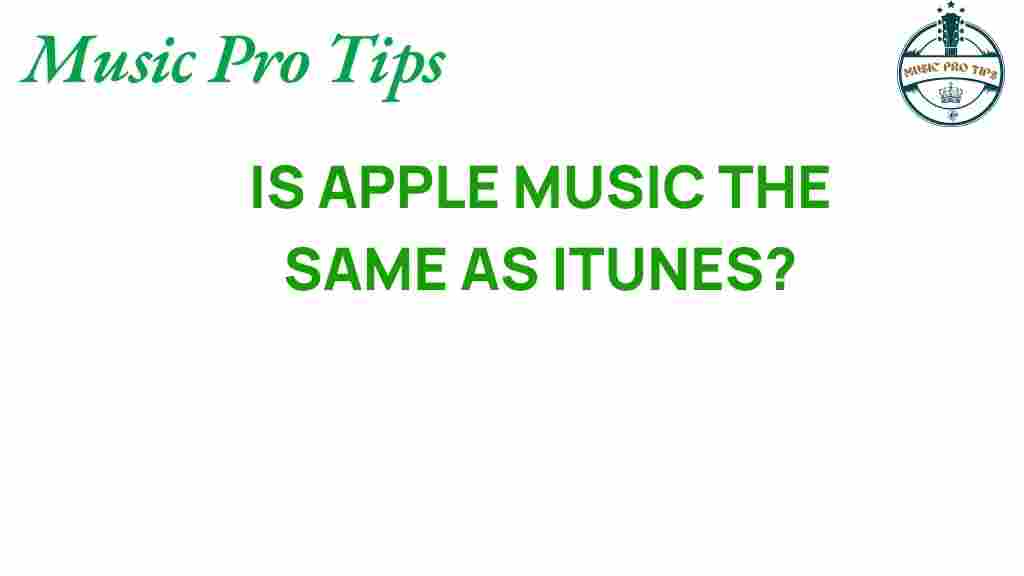Is Apple Music Just a Modern iTunes Reboot?
When Apple Music was launched in 2015, it was touted as a revolutionary step in the music industry, offering a streaming service that aimed to change how we access and enjoy digital music. Many users wondered whether Apple Music was simply a modern reboot of iTunes, which had dominated the digital music space for years. In this article, we will explore the similarities and differences between Apple Music and iTunes, the evolution of streaming services, and how the user experience has shifted in the age of subscription models.
The Transition from iTunes to Apple Music
iTunes was launched in 2001 as a media player and digital music library. It revolutionized how we purchased, organized, and listened to music. However, with the rise of streaming services like Spotify and Pandora, the music consumption landscape began to shift. Here’s how Apple Music fits into this transition:
- Digital Music Consumption: iTunes focused on purchasing individual songs and albums, while Apple Music shifted towards a subscription model that allowed users to stream an entire music library.
- Music Library Expansion: Apple Music offers access to over 70 million songs, which dwarfs the individual purchases typically made through iTunes.
- User Experience: The user interface of Apple Music is designed for easy navigation and discovery, contrasting with the more catalog-driven interface of iTunes.
Understanding the Subscription Model
One of the most significant differences between iTunes and Apple Music is the subscription model. Apple Music operates on a monthly fee structure, allowing users to access a vast library of songs without the need to purchase each track individually. This model has several advantages:
- Cost Efficiency: For avid music listeners, a subscription often proves to be more economical than buying individual tracks.
- Access to Exclusive Content: Apple Music provides exclusive releases, curated playlists, and music recommendations tailored to individual tastes.
- Offline Listening: Subscribers can download songs for offline listening, a feature not available in the traditional iTunes model.
The Role of Streaming Services in Today’s Music Landscape
The rise of streaming services has transformed the music industry. Here’s how Apple Music fits into this broader context:
- Competition: Apple Music competes with other major streaming services like Spotify, Amazon Music, and YouTube Music, each offering unique features and libraries.
- User Engagement: Streaming services encourage user engagement through playlists, social sharing, and personalized recommendations.
- Artist Revenue: With the subscription model, artists earn revenue based on the number of streams rather than album sales, changing how music is monetized.
Enhancing the User Experience
Apple Music focuses on providing an enhanced user experience, which is critical in the competitive landscape of digital music. Here are some key features that contribute to this:
- Curated Playlists: Apple Music offers expertly curated playlists, helping users discover new music based on their tastes and preferences.
- Integration with Other Apple Services: Seamless integration with other Apple products and services, such as Siri and Apple Watch, enhances usability.
- Visual and Interactive Elements: The platform provides visually appealing album artwork and interactive elements that engage users more than traditional media players.
Comparing Media Players: iTunes vs. Apple Music
While iTunes was primarily a media player for managing digital music collections, Apple Music has evolved beyond that functionality. Here’s a comparison:
| Feature | iTunes | Apple Music |
|---|---|---|
| Model | Purchase-based | Subscription-based |
| Music Library | User’s collection | Streaming access to vast library |
| Offline Music | Downloaded tracks only | Downloadable for offline listening |
| Social Features | Limited | Extensive sharing and collaborative playlists |
How to Transition from iTunes to Apple Music
If you are considering making the switch from iTunes to Apple Music, here’s a step-by-step guide to help you:
- Sign Up for Apple Music: Visit the Apple Music website or download the app. Choose a subscription plan that suits your needs.
- Import Your iTunes Library: Apple Music allows you to import your existing iTunes library, so you won’t lose your music collection.
- Explore the Interface: Familiarize yourself with the Apple Music interface, including the “For You” section, which offers personalized playlists and suggestions.
- Download the App: Download the Apple Music app on your mobile device to listen on the go.
- Create Playlists: Start creating playlists using both your imported music and new tracks available on Apple Music.
Troubleshooting Common Issues
As with any technology, users may encounter issues when transitioning from iTunes to Apple Music. Here are some common troubleshooting tips:
- Music Not Importing: Ensure your iTunes library is properly synced with your Apple ID. Check for updates to both iTunes and Apple Music.
- Playback Issues: Restart the app or your device. Ensure you have a stable internet connection for streaming.
- Subscription Problems: If you encounter issues with your subscription, check your payment method and Apple ID settings.
Conclusion: The Future of Digital Music
In conclusion, Apple Music can be seen as a modern reboot of iTunes, but it represents much more than just a facelift. It embodies the shift in how we consume digital music through streaming services and subscription models. With its extensive music library, enhanced user experience, and integration with Apple’s ecosystem, Apple Music is well-positioned to continue shaping the future of music consumption.
As technology evolves, so too will the platforms we use to enjoy our favorite tunes. For more information on digital music trends, you can check out this external link. If you’re looking to enhance your digital music experience, consider exploring the features of Apple Music and how it can fit into your lifestyle.
For more insights and tips on digital music, visit our internal link to discover additional articles on the topic.
This article is in the category Software and created by MusicProTips Team

1 thought on “Is Apple Music Just a Modern iTunes Reboot?”